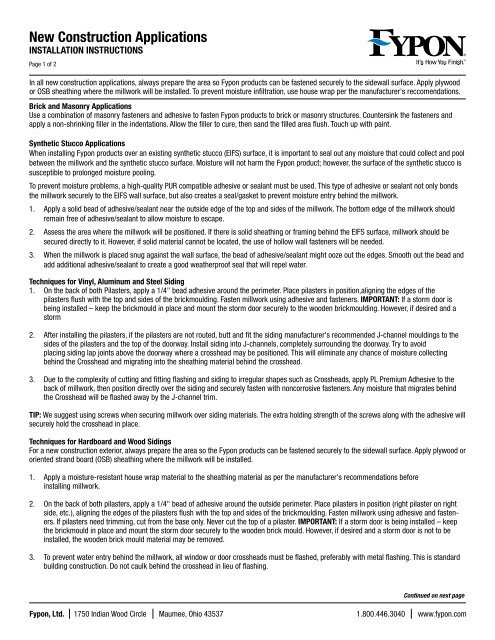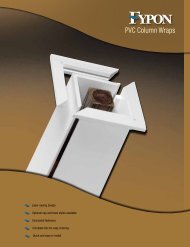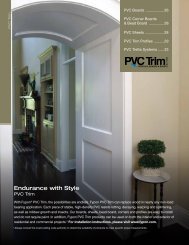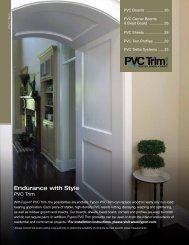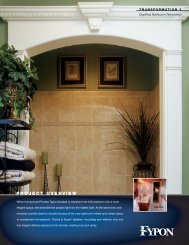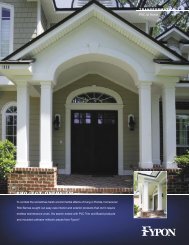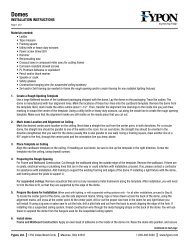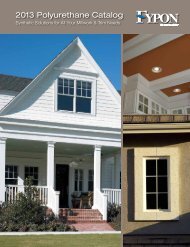new construction applications - Fypon, Ltd.
new construction applications - Fypon, Ltd.
new construction applications - Fypon, Ltd.
You also want an ePaper? Increase the reach of your titles
YUMPU automatically turns print PDFs into web optimized ePapers that Google loves.
TMNew Construction ApplicationsInstallation InstructionsPage 1 of 2In all <strong>new</strong> <strong>construction</strong> <strong>applications</strong>, always prepare the area so <strong>Fypon</strong> products can be fastened securely to the sidewall surface. Apply plywoodor OSB sheathing where the millwork will be installed. To prevent moisture infiltration, use house wrap per the manufacturer's reccomendations.Brick and Masonry ApplicationsUse a combination of masonry fasteners and adhesive to fasten <strong>Fypon</strong> products to brick or masonry structures. Countersink the fasteners andapply a non-shrinking filler in the indentations. Allow the filler to cure, then sand the filled area flush. Touch up with paint.Synthetic Stucco ApplicationsWhen installing <strong>Fypon</strong> products over an existing synthetic stucco (EIFS) surface, it is important to seal out any moisture that could collect and poolbetween the millwork and the synthetic stucco surface. Moisture will not harm the <strong>Fypon</strong> product; however, the surface of the synthetic stucco issusceptible to prolonged moisture pooling.To prevent moisture problems, a high-quality PUR compatible adhesive or sealant must be used. This type of adhesive or sealant not only bondsthe millwork securely to the EIFS wall surface, but also creates a seal/gasket to prevent moisture entry behind the millwork.1. Apply a solid bead of adhesive/sealant near the outside edge of the top and sides of the millwork. The bottom edge of the millwork shouldremain free of adhesive/sealant to allow moisture to escape.2. Assess the area where the millwork will be positioned. If there is solid sheathing or framing behind the EIFS surface, millwork should besecured directly to it. However, if solid material cannot be located, the use of hollow wall fasteners will be needed.3. When the millwork is placed snug against the wall surface, the bead of adhesive/sealant might ooze out the edges. Smooth out the bead andadd additional adhesive/sealant to create a good weatherproof seal that will repel water.Techniques for Vinyl, Aluminum and Steel Siding1. On the back of both Pilasters, apply a 1/4" bead adhesive around the perimeter. Place pilasters in position,aligning the edges of thepilasters flush with the top and sides of the brickmoulding. Fasten millwork using adhesive and fasteners. IMPORTANT: If a storm door isbeing installed – keep the brickmould in place and mount the storm door securely to the wooden brickmoulding. However, if desired and astorm2. After installing the pilasters, if the pilasters are not routed, butt and fit the siding manufacturer's recommended J-channel mouldings to thesides of the pilasters and the top of the doorway. Install siding into J-channels, completely surrounding the doorway. Try to avoidplacing siding lap joints above the doorway where a crosshead may be positioned. This will eliminate any chance of moisture collectingbehind the Crosshead and migrating into the sheathing material behind the crosshead.3. Due to the complexity of cutting and fitting flashing and siding to irregular shapes such as Crossheads, apply PL Premium Adhesive to theback of millwork, then position directly over the siding and securely fasten with noncorrosive fasteners. Any moisture that migrates behindthe Crosshead will be flashed away by the J-channel trim.TIP: We suggest using screws when securing millwork over siding materials. The extra holding strength of the screws along with the adhesive willsecurely hold the crosshead in place.Techniques for Hardboard and Wood SidingsFor a <strong>new</strong> <strong>construction</strong> exterior, always prepare the area so the <strong>Fypon</strong> products can be fastened securely to the sidewall surface. Apply plywood ororiented strand board (OSB) sheathing where the millwork will be installed.1. Apply a moisture-resistant house wrap material to the sheathing material as per the manufacturer's recommendations beforeinstalling millwork.2. On the back of both pilasters, apply a 1/4" bead of adhesive around the outside perimeter. Place pilasters in position (right pilaster on rightside, etc.), aligning the edges of the pilasters flush with the top and sides of the brickmoulding. Fasten millwork using adhesive and fasteners.If pilasters need trimming, cut from the base only. Never cut the top of a pilaster. IMPORTANT: If a storm door is being installed – keepthe brickmould in place and mount the storm door securely to the wooden brick mould. However, if desired and a storm door is not to beinstalled, the wooden brick mould material may be removed.3. To prevent water entry behind the millwork, all window or door crossheads must be flashed, preferably with metal flashing. This is standardbuilding <strong>construction</strong>. Do not caulk behind the crosshead in lieu of flashing.Continued on next page<strong>Fypon</strong>, <strong>Ltd</strong>. 1750 Indian Wood Circle Maumee, Ohio 43537 1.800.446.3040 www.fypon.com
New Construction Applications ContinuedPage 2 of 2Installing Siding Around Irregular Shaped TrimPilasters1. Fasten the millwork directly to the house-wrapped sheathing using adhesive and fasteners. To prevent water entry behind the top of thebrickmoulding, flash the top of the brickmoulding and pilasters.2. Next, install exterior siding. At the point where the exterior siding terminates and the pilasters begin, leave a 3/16" gap and fill with a highquality, non-shrinking caulk.CrossheadsWhen installing irregular shaped Crossheads, it is important to apply vertical strips of vinyl undersill finish trim to prevent moisture from collectingbehind the millwork. Trapped water will deteriorate the surface of the wood or hardboard siding. Use adhesive and galvanized roofing nails tosecure the undersill strips vertically every 16"- 24" to the back of the crosshead.1. Position the crosshead 3/16" above the top of the brick mould to allow any moisture that might collect to escape.2. Next, securely fasten the crosshead in place using adhesive and fasteners.3. Finally, countersink fasteners and fill with plastic wood filler. Sand flush and touch up with paint.TIP: We recommend using screws when securing the crosshead over the siding material. The extra holding strength of the screws along with theadhesive will securely hold the crosshead in place.General Installation NotesAny adhesives, sealants, fillers or paint used must be compatible with the material that is being installed (see manufacturer’s recommendations in theFinishing and Adhesives section below). Always use corrosion-resistant mechanical nails or screws along with manufacturer’s recommended adhesiveproduct when installing all <strong>Fypon</strong> products. This combination provides a secure, long-lasting bond. Countersink all fasteners about 1/8" and fillwith manufacturer’s recommended filler. Exterior installations should be finished using a manufacturer’s recommended caulk to prevent waterinfiltration behind siding, windows and doors. Some exterior installations, in particular <strong>new</strong> <strong>construction</strong> before siding is applied, may require aJ-channel and/or flashing to prevent water infiltration. Installers must determine which installation technique is best for the specific situation.Finishing and AdhesivesPolyurethane (PUR) – Depending on product location, always use interior/exterior-grade, PUR compatible adhesives, sealants, and fillers wheninstalling <strong>Fypon</strong> products. Consult the manufacturer’s recommendations for your particular climate and the substrate you are installing to. <strong>Fypon</strong>polyurethane products are factory primed, and applying a top coat using an exterior-grade 100% acrylic latex paint is required on all exteriorinstallations.Cellular PVC – Depending on product location, always use interior/exterior-grade, PVC compatible adhesives, sealants, and fillers when installing<strong>Fypon</strong> products. Consult the manufacturer’s recommendations for your particular climate and the substrate you are installing to. If painting isdesired, a 100% acrylic latex paint with a Light Reflectance Value (LRV) of 55% or higher must be used. Applying paint with an LRV of 54% orlower will void the warranty.IMPORTANT:Please read these installation guidelines thoroughly before beginning installation. Please note that these guidelines are provided only to assist with the installation of <strong>Fypon</strong> mouldingand millwork products. Modified procedures may be required in order to meet specific situations, unique <strong>applications</strong> and local building codes. The manufacturer does not, under anycircumstances, warrant the installation of its products. Be sure to wear appropriate protective clothing, gloves and safety glasses when working with any tools. Installer should checkfor and relocate all electrical wiring within the proposed installation area, as needed (be sure to disconnect all electric power before working with any electrical wiring and follow allapplicable local electrical codes and safety procedures).<strong>Fypon</strong>, <strong>Ltd</strong>. 1750 Indian Wood Circle Maumee, Ohio 43537 1.800.446.3040 www.fypon.com


